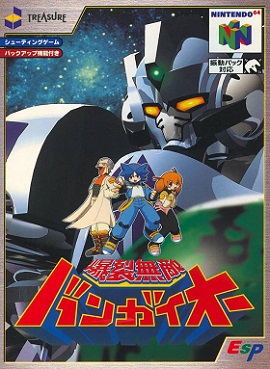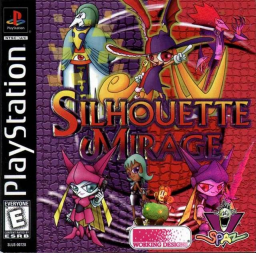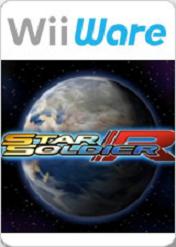
R-Type is a horizontally scrolling shooter arcade video game developed and released by Irem in 1987 and the first game in the R-Type series. The player controls a star ship, the R-9 "Arrowhead", in its efforts to destroy the Bydo, a powerful alien race bent on wiping out all of mankind. The R-9 can acquire a glowing orbicular device called a "Force", protecting it from enemy fire and providing additional firepower. The arcade version was distributed by Nintendo in North America; it is the last arcade title Nintendo distributed.

Bangai-O is a multidirectional shooter developed by Treasure and released in 1999 on the Nintendo 64 in Japan. It was ported to the Dreamcast worldwide shortly after with some gameplay changes and updated graphics and audio. The game places the player in control of a weaponized mech that can hover across large stages and fire at enemies all around them. The player must reach the end of each stage and defeat the boss, while avoiding hazards scattered across the map such as enemy mechs and gun turrets.

Einhänder is a scrolling shooter developed by Square for the PlayStation console. It was released in Japan on November 20, 1997 and in North America on May 5, 1998. It was also re-released for the Japanese PlayStation Network on June 25, 2008. The name Einhänder is German and denotes a type of sword that is wielded with one hand, here used to refer to the single manipulator arm possessed by the player's spacecraft.

Silhouette Mirage is a 2D action side-scrolling video game developed by Treasure and released in 1997. The game's primary mechanic is the two opposing attributes, "Silhouette" and "Mirage" and the way they are able to cause damage to each other. Shyna features as the female protagonist who is able to switch between these attributes at will by facing either left or right on-screen. Secondary mechanics in the form of various melee moves are used to get enemies onto the correct side of the screen so that when Shyna is facing them, she is able to use the correct, opposing attribute to damage them.

R-Types is a 1998 shoot'em up video game compilation developed and published by Irem for the PlayStation. It was published by ASCII Corporation in North America, and by Virgin Interactive in Europe. R-Types contains two games from Irem's R-Type franchise - the original R-Type (1987) and its direct sequel R-Type II (1989) - alongside bonus material such as promotional artwork and a gallery spanning the series' history.

R-Type II is a horizontally scrolling shooter developed and published by Irem. It was released in arcades in 1989. It is the sequel to R-Type, and the second game in the R-Type series.

R-Type Leo is a 1992 horizontal-scrolling shooter arcade game developed by Nanao and published by Irem. It is a spin-off of the R-Type series and the last R-Type entry to be released in arcades. In Leo, players take control of the titular space fighter to travel the man-made mechanical planet Eden and destroy its supercomputer core Major. The game was initially conceived as an original shoot 'em up by Nanao before being retooled into an R-Type project by Irem. The title was met with positive reception from reviewers. It has since been re-released as part of Dotemu's 2010 Irem Arcade Hits compilation.

In the Hunt is a 1993 scrolling shooter arcade video game developed and published by Irem. Versions for the PlayStation, Sega Saturn, and Microsoft Windows were also released. The player assumes control of the Granvia, a submarine tasked with overthrowing the Dark Anarchy Society before they activate their doomsday device. Gameplay involves shooting enemies, collecting power-up items, and avoiding collision with projectiles. It runs on the Irem M-92 hardware.

G-Darius is a shoot'em up arcade game, released by Taito in 1997. It is the fourth arcade installment of the Darius series and the first in the series to feature three-dimensional polygonal graphics.

RayStorm is a 1996 vertically scrolling shooter arcade video game developed and published by Taito. It has been ported to several consoles, including the PlayStation, Sega Saturn, and Xbox 360. Players control a starship, the R-Gray, in its mission to destroy the Secilia Federation before it destroys Earth.

Pulstar is a horizontally scrolling shooter released for arcades by SNK in 1995. Players control a starship in its mission to eradicate the Solar System of a hostile race of aliens that threaten mankind. Its gameplay has been compared to the R-Type series for its similar premise and mechanics; players must complete each of the game's eight stages by destroying constantly-moving formations of enemies and avoiding their projectiles. There are power-ups that can be collected that provide additional abilities for the player. It runs on the Neo Geo MVS arcade system board.

Gunhed, known as Blazing Lazers in North America, is a vertically scrolling shooter game by Hudson Soft and Compile, based on the Japanese film Gunhed. The title was released in 1989, for the PC Engine in Japan and re-skinned for the TurboGrafx-16 in North America, with Gunhed unofficially imported for the PC Engine in Europe. In the game, a fictional galaxy is under attack by an enemy space armada called the Dark Squadron, and this galaxy's only chance for survival is the Gunhed Advanced Star Fighter, who must destroy the Dark Squadron and its Super Weapons. The gameplay features fast vertical scrolling and a wide array of weapons for the player to use.

Xexex, released as Orius in North America, is a 1991 side-scrolling shoot 'em up arcade game by Konami. It draws on Irem's R-Type and Konami's other shoot 'em up Gradius, while adding the tentacle mechanics of Irem's other shoot 'em up XMultiply. In the game, players take control of the Flintlock space fighter in a mission to rescue Princess Irene La Tias of Planet E-Square, who has been captured by the evil galactic warlord Klaus Pachelbel.

Cosmic Cop is a side-scrolling shoot 'em up arcade game produced by Irem in 1991. It is part of the popular R-Type video game series.

Star Soldier R is a futuristic scrolling shooter video game developed by Hudson Soft, and is the seventh installment in the Star Soldier series. The game features classic Star Soldier gameplay combined with 3D graphics.

Godzilla Generations is an action game developed by General Entertainment and published by Sega for the Dreamcast in 1998. It was exclusively released in Japan as one of the system's four launch titles. The game is based on the Godzilla franchise and involves the player controlling various giant monsters in an attempt to destroy real-life Japanese cities.

Ape Escape is a platform video game, developed by Japan Studio and published by Sony Computer Entertainment. It was released for the PlayStation in June 1999 in North America and Japan, and July 1999 in Europe. The first in the Ape Escape series, the game tells the story of an ape named Specter who gains enhanced intelligence and a malevolent streak through the use of an experimental helmet. Specter produces an army of apes, which he sends through time in an attempt to rewrite history. Spike, the player character, sets out to capture the apes with the aid of special gadgets.

R-Type Tactics II: Operation Bitter Chocolate is a turn-based strategy tactical role-playing game released in 2009 in Japan for the PlayStation Portable game console. It is the sequel to 2007's R-Type Tactics. The main part of the game consists of three campaigns, in which the player controls two human factions, then the Bydo Empire.
Resogun is a shoot 'em up video game developed by Housemarque and published by Sony Computer Entertainment for the PlayStation 4. It was originally released in North America and PAL regions in November 2013, while ports for PlayStation 3 and PlayStation Vita developed by Climax Studios were released in December 2014. Resogun: Heroes, the first downloadable content (DLC), was released in North America on June 24, 2014, while the second DLC, Resogun: Defenders was released on February 17, 2015. Resogun draws heavily from the games Defender and Datastorm, and is considered the spiritual successor to Housemarque's previous shoot 'em up games Super Stardust HD and Super Stardust Delta.

Rainbow Cotton is a 2000 rail shooter video game developed and published by Success exclusively for the Dreamcast. The fifth installment in the Cotton franchise, it is a follow-up to Panorama Cotton (1994) and the first 3D entry in the series. In the game, players assume the role of the titular young witch who, alongside her fairy companion Silk, sets out on her broomstick on a quest to defeat the evil demon Tweed and retrieve a stolen Willow candy from York Country. Its gameplay is similar to Panorama Cotton, consisting of shooting mixed with role-playing game elements while flying through 3D environments on a predetermined track.

















